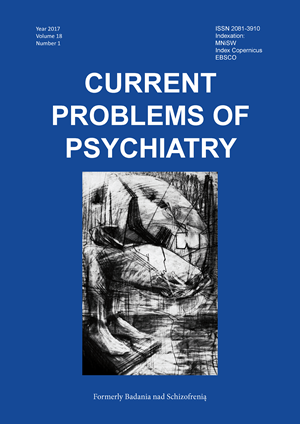Terminalna jasność umysłu
DOI:
https://doi.org/10.1515/cpp-2017-0003Słowa kluczowe:
terminalna jasność umysłu, rozjaśnienie przed śmiercią, doświadczenia końca życia, pamięćAbstrakt
Terminalna jasność umysłu to termin stosowany w literaturze medycznej do określenia poprawy stanu umysłowego na krótko przed śmiercią, nawet u osób z wieloletnimi zaburzeniami w obrębie funkcjonowania poznawczego. W XIX w. przypadki odzyskania wcześniej zmąconego umysłu na krótko przed śmiercią były często rozpoznane przez lekarzy i interpretowane jako znak zbliżającej się śmierci. W XX w. zainteresowanie tym zjawiskiem spadło, aby praktycznie zniknąć. W ostatnich latach, na fali publikacji dotyczących doświadczeń śmierci klinicznej (near death experiences) i pokrewnych jej zjawisk jak doświadczenia końca życia (end of life experien-ces), liczba prac gwałtownie wzrosła, a poprawa stanu umysłowego na krótko przed śmiercią uzyskała nową nazwę: terminalna jasność umysłu (terminal lucidity). W pracy przedstawiono przegląd dostępnej literatury, aby zarysować obraz historyczny, fenomenologiczny i kliniczny tego zjawiska oraz jego ewentualne implikacje dla opieki medycznej i przyszłych badań.
Bibliografia
1. Nahm, M., Greyson, B., Kelly, E. W., & Haraldsson, E. (2012). Terminal lucidity: A review and a case collection. Archives of gerontology and geriatrics, 55(1), 138-142.
2. Rush, B. (1812). Mental inquiries and observations upon diseases of the mind. Philadelphia, PA: Kimber & Richardson.
3. Halford, H. (1842). Essays and orations, read and delivered at the Royal College of Physicians: to which is added an account of the opening of the tomb of King Charles I. John Murray.
4. Brierre de Boismont, A. (1845/1859). A history of dreams, visions, apparitions, ecstasy, magnetism and somnambulism. Henry Renshaw, 356, STRAND. London
5. Hughes, N., & Clark, D. (2004). " A Thoughtful and Experienced Physician": William Munk and the Care of the Dying in Late Victorian England. Journal of palliative medicine, 7(5), 703-710.
6. Munk W (1887). Euthanasia: or, Medical Treatment in Aid of an Easy Death. London: Longmans, Green and Co.
7. Macleod, A. S. (2009). Lightening up before death. Palliative and Supportive Care, 7(04), 513-516.
8. Nahm, M., & Greyson, B. (2009). Terminal lucidity in patients with chronic schizophrenia and dementia: A survey of the literature. The Journal of nervous and mental disease, 3(12), 942-944.
9. Marshal, A. (1815). The morbid anatomy of the brain in mania and hydrophobia. London, England: Longman.
10. Raymond, M. (2011). Życie po życiu. Zysk i S-ka: Poznań.
11. Nahm, M. (2011). Reflections on the Context of Near-Death Experiences. Journal of Scientific exploration, 25(3).
12. Fenwick, P., Fenwick, E. (2008/2014). El arte de morir. Editorial Atalanta: Girona, España.
13. Nahm, M. (2009). Terminal lucidity in people with mental illness and other mental disability: An overview and implications for possible explanatory models. Jounal of Near-Death Studies, 28(2), 87-106.
14. Schubert, G. H. (1967). Ansichten von der Nachtseite der Naturwissenschaft. Darmstadt, Germany: Wissenschaftliche Buchgesellschaft. (Original work published 1808).
15. Haig, S., 2007. The brain: the power of hope. Time Magazine 169, 118-119.
16. Ethier, A. M. (2005). Continuing Education Credit Article Death-Related Sensory Experiences. Journal of Pediatric Oncology Nursing, 22(2), 104-111.
17. Ringger, P. (1958). Die Mystik im Irrsinn. Neue Wissenschaft, 8, 217-220.
18. Nahm, M., & Greyson, B. (2014). The Death of Anna Katharina Ehmer: A Case Study in Terminal Lucidity. OMEGA-Journal of Death and Dying, 68(1), 77-87.
19. Peters, U. H. (1996). The first Royal College. The Psychiatrist, 20(5), 307-307.
20. Fenwick, P., Lovelace, H., & Brayne, S. (2010). Comfort for the dying: five year retrospective and one year prospective studies of end of life experiences. Archives of gerontology and geriatrics, 51(2), 173-179.
21. Macleod, A. S. (2011). The Psychiatry of Palliative Medicine. The dying mind. Radcliffe Publishing.
22. Braithwaite, J.J., & Dewe, H (2014). Occam’s chainsaw: Neuroscientific nails in the coffin of dualist notions of the neardeath Experience (NDE). The [UK] Skeptic magazine, (25) 2, pp24-31; http://www.academia.edu/10060970/Occams_Chainsaw_Neuroscientific_Nails_in_the_coffin_of_dualist_notions_of_the_Near-death_experience_NDE_
23. Goldestein, N., Morrison, R. (2012). Evidence-based practice of palliative medicine. Elsevier Health Sciences.
Pobrania
Opublikowane
Numer
Dział
Licencja
Prawa autorskie (c) 2017 Autorzy

Praca jest udostępniana na licencji Creative Commons Attribution-NonCommercial-NoDerivatives 3.0 Unported License.


